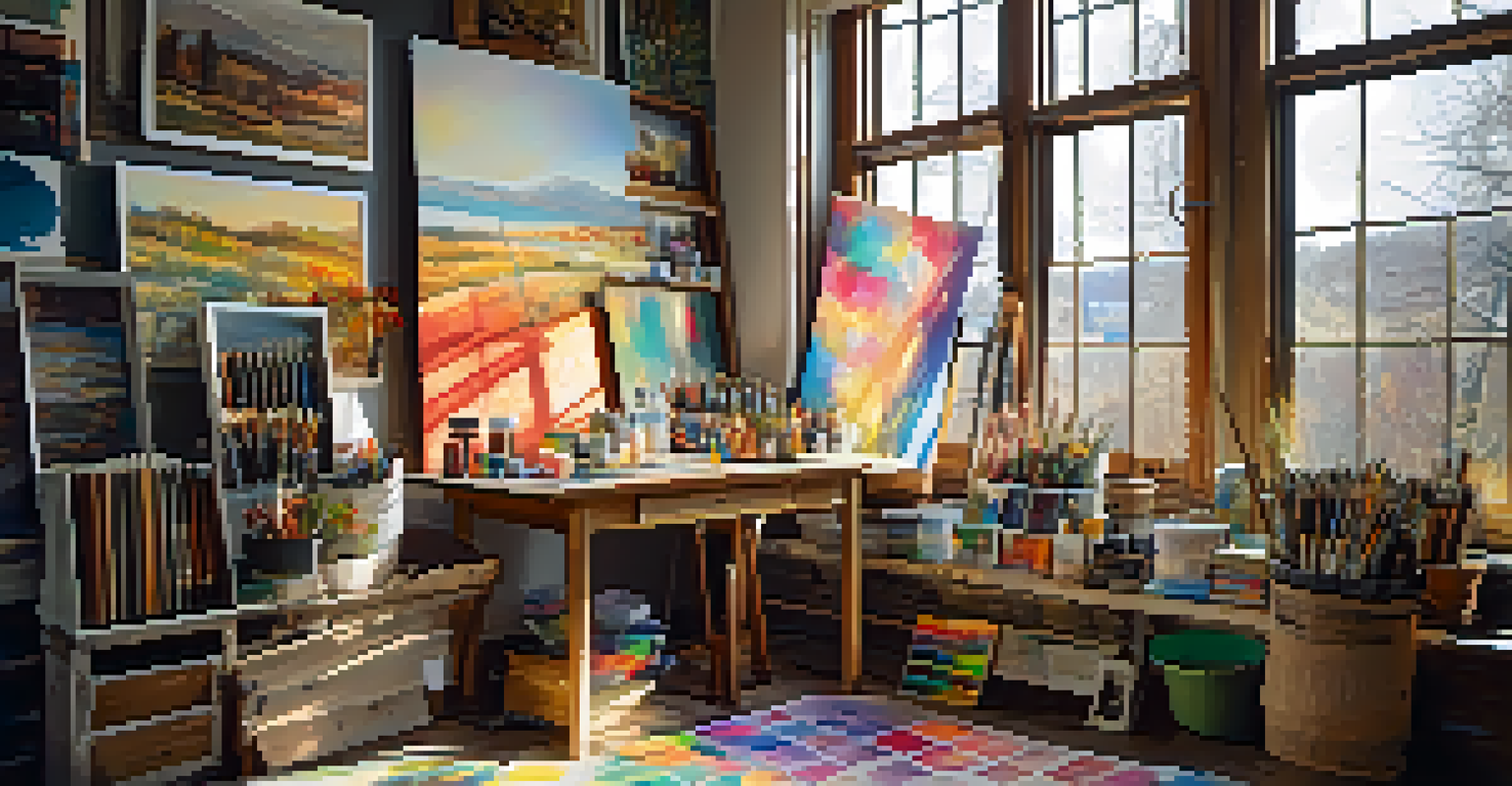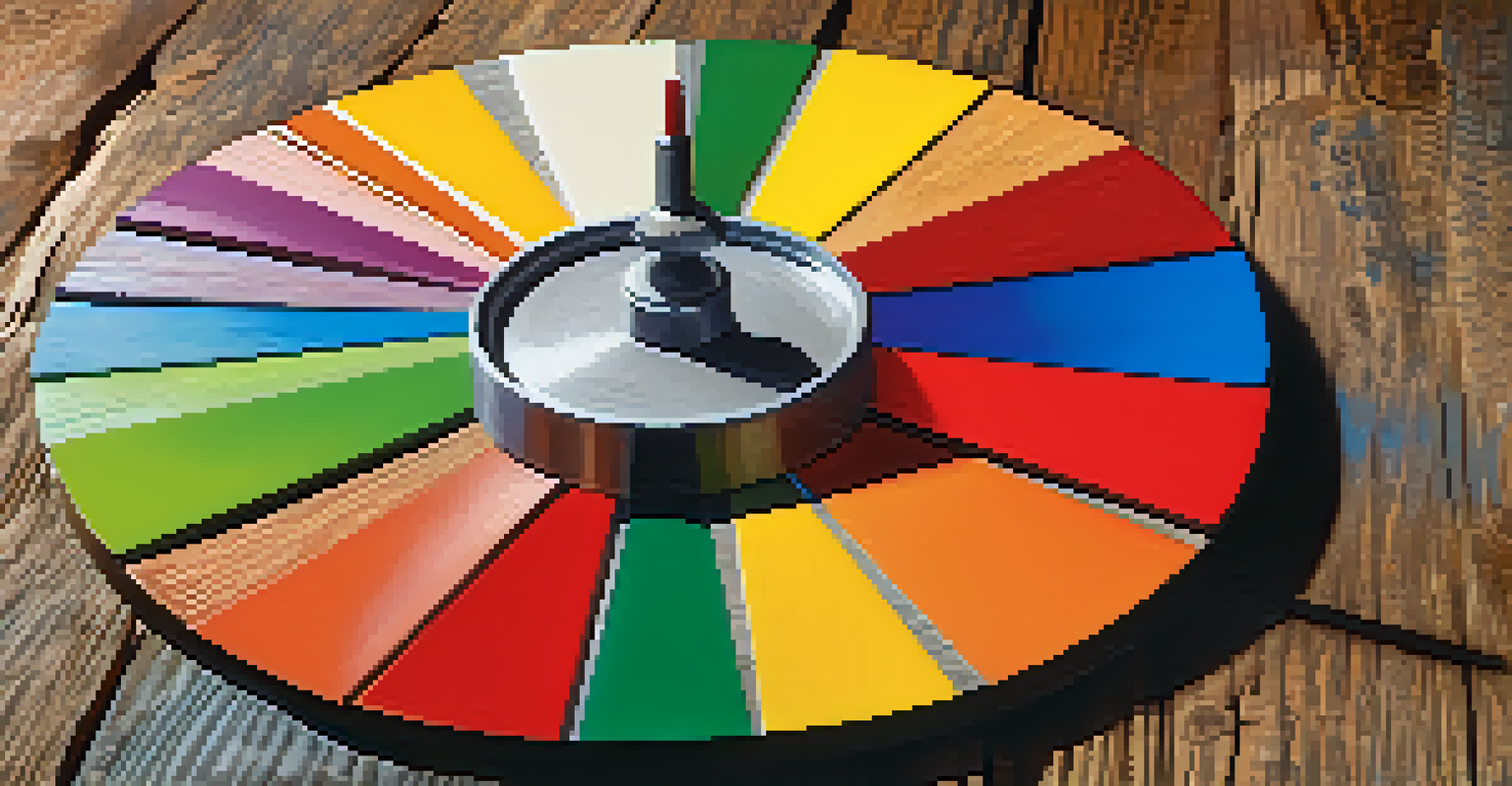Color Theory Applications: From Canvas to Digital Art

Understanding the Basics of Color Theory
Color theory is the study of how colors interact and the emotions they evoke. It’s like a secret language that artists use to communicate feelings and ideas through their work. By grasping the fundamentals, such as primary, secondary, and tertiary colors, artists can create harmonious palettes that resonate with viewers.
Color is the keyboard, the eyes are the harmonies, the soul is the piano with many strings.
At its core, color theory helps artists understand the relationships between colors, whether they are mixing paints on a canvas or selecting shades digitally. For instance, complementary colors, which sit opposite each other on the color wheel, can create striking contrasts that draw attention. This knowledge empowers artists to make informed choices that enhance the overall impact of their creations.
Moreover, understanding color temperature—warm versus cool colors—can significantly influence the mood of a piece. Warm colors like reds and yellows can invoke feelings of warmth and excitement, while cool colors like blues and greens can promote calmness. Mastering these concepts allows artists to effectively convey their intended message through visual storytelling.
The Role of Color in Traditional Art
In traditional art forms, color plays a pivotal role in composition and storytelling. Artists carefully select colors to evoke specific emotions and guide the viewer's eye throughout the artwork. For example, the use of vibrant reds and yellows can create a sense of energy, while softer pastels may evoke nostalgia and tranquility.

Beyond emotional impact, color can also serve practical purposes in traditional art. Different pigments have unique properties, and understanding how they mix and interact can lead to richer, more dynamic compositions. This is particularly important for painters who want to achieve depth and dimension in their work.
Color Theory Basics Explained
Understanding primary, secondary, and complementary colors helps artists create impactful and harmonious artworks.
Take, for instance, the famous works of Van Gogh, where bold colors not only express emotion but also enhance the narrative of his subjects. His paintings illustrate how color can transform a simple scene into a powerful experience, highlighting the importance of intentional color choices in traditional art.
Digital Art and the Evolution of Color Use
The digital art landscape has revolutionized how artists use color, providing tools that were previously unimaginable. With software like Adobe Photoshop and Procreate, artists can experiment with an endless array of colors and effects, allowing for unprecedented creativity. This flexibility enables artists to explore new styles and techniques without the limitations of physical media.
Colors are the smiles of nature.
In the digital realm, color selection tools, such as color pickers and gradients, make it easier for artists to achieve the desired look. Artists can also manipulate color intensity and saturation with just a few clicks, providing instant feedback on how changes affect the overall composition. This immediacy has transformed the creative process, allowing for rapid iteration and experimentation.
Moreover, the digital format has introduced new concepts, such as RGB and CMYK color models, which are essential for screen and print media, respectively. Understanding these models helps artists make informed decisions about how their work will be viewed, ensuring that their vibrant visions translate effectively across different platforms.
Color Psychology: How Colors Influence Emotions
Color psychology delves into how different colors can impact human emotions and behaviors. This knowledge is invaluable for artists who wish to evoke specific reactions from their audience. For instance, warm colors like red and orange can stimulate excitement and passion, while cool colors like blue and green tend to promote calmness and relaxation.
In both traditional and digital art, artists can leverage color psychology to strengthen their narratives. A well-placed pop of yellow may evoke joy, while deep shadows of purple can create a sense of mystery. By understanding the emotional weight of colors, artists can craft more compelling stories and engage their viewers on a deeper level.
Cultural Impact on Color Meaning
Colors can have different interpretations across cultures, making it vital for artists to consider these variations in their work.
This aspect of color theory is not just limited to art; it extends into marketing and branding as well. Companies often use specific colors in their logos and advertising to elicit desired feelings from consumers. Artists can draw on these principles to create work that resonates not only aesthetically but emotionally.
The Impact of Cultural Differences on Color Perception
Colors can carry different meanings across cultures, making it essential for artists to be aware of these variations. For example, while white is often associated with purity and weddings in Western cultures, it can symbolize mourning in some Eastern cultures. This cultural context influences how an audience interprets an artwork's colors and themes.
When creating art for a global audience, artists must consider these cultural nuances to ensure their work communicates effectively. A color that evokes joy in one culture might be seen as offensive in another. By doing research and understanding the cultural implications of color, artists can create work that resonates universally.
This awareness extends to digital art, where artists often share their work across international platforms. In a world that is increasingly connected, being sensitive to these differences can enhance the impact of an artwork, making it more inclusive and relatable to diverse audiences.
Combining Color Theory with Artistic Styles
Artists can enhance their unique styles by integrating color theory principles into their work. For example, impressionist painters like Monet used color to capture light and movement, applying color theory to create vibrant landscapes that evoke emotion. By experimenting with different palettes, artists can find what resonates best with their personal expression.
In digital art, artists have the opportunity to blend various styles and techniques, allowing for even more creative freedom. Using color theory as a foundation, they can mix elements of realism with abstraction to craft dynamic compositions. This blending of styles highlights the versatility of color and how it can elevate an artist's vision.
Practical Tips for Using Color
Experimenting with color wheels and limited palettes can enhance an artist's understanding and application of color theory.
Ultimately, the fusion of color theory with artistic styles encourages experimentation and growth. Artists can push their creative boundaries by stepping outside conventional norms and exploring how colors can shift the perception of their work, making each piece a unique reflection of their artistic journey.
Practical Tips for Applying Color Theory in Your Art
Applying color theory in your art doesn't have to be daunting; there are simple strategies to get started. Begin by creating a color wheel to visualize relationships between colors, helping you understand which combinations work harmoniously. This foundational tool can serve as a reference for both traditional and digital projects.
Another effective approach is to limit your palette to a few colors, forcing yourself to explore the depth and variety within those hues. This technique can lead to unexpected discoveries and a more cohesive overall look in your artwork. Don’t be afraid to experiment—sometimes the best results come from trial and error.

Lastly, take inspiration from existing artworks or color schemes in nature. By studying how other artists utilize color, you can gather ideas and develop your own unique style. Remember, the key to mastering color theory is practice, so keep experimenting and let your creativity flourish!